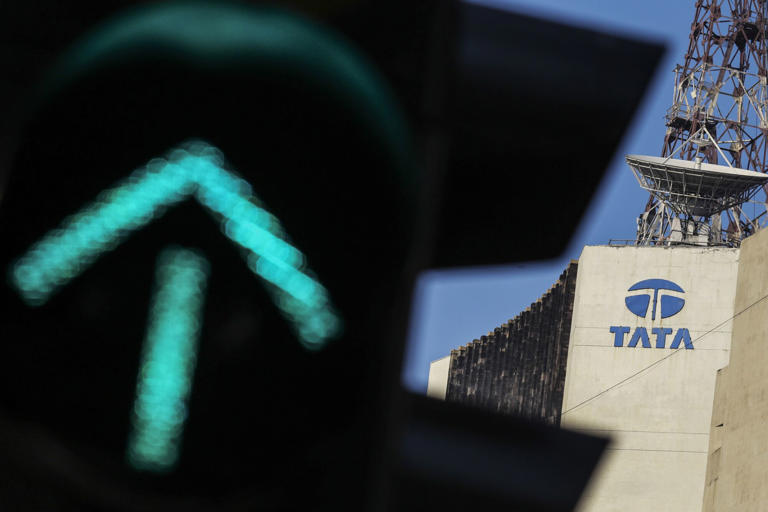- Tata’s facility set to be India’s first major chip factory
Prime Minister Narendra Modi’s cabinet approved Tata’s plan to build an $11 billion site that can fabricate about 50,000 wafers per month, technology minister Ashwini Vaishnaw told reporters in New Delhi Thursday. The government also cleared Tata’s separate proposal for a $3 billion-plus chip assembly plant, and a packaging venture between Japan’s Renesas Electronics Corp. and the Murugappa Group’s CG Power and Industrial Solutions Ltd.

Signage for Tata Communications Ltd. is displayed atop of the company's headquarters as traffic signal stands in Mumbai, India, on Saturday, Nov. 5, 2016. Cyrus Mistry, the ousted chairman of India's biggest conglomerate, was replaced as Tata Sons chairman by his 78-year-old predecessor Ratan Tata at a board meeting on Oct. 24. Tata Sons said the conglomerate's board and Trustees of the Tata Trusts were concerned about a growing “trust deficit” with Mistry, which prompted the company to remove him.© Bloomberg
While still merely blueprints, the approvals advance India’s semiconductor ambitions. Like a growing number of countries around the world, the Modi administration is keen to endorse and back the building of domestic chipmaking capacity, ensuring supply of the components needed for future technologies from AI to self-driving cars.
“We will start construction of this plant within 100 days,” the minister said during the briefing, referring to Tata’s fab.
India hopes to attract chip giants in much the same way incentives have encouraged Apple Inc. and its partners to make and sell iPhones in the country, a boost to its giant manufacturing sector. It’s offered to shoulder half the cost of any approved projects, up to an initial ceiling of $10 billion. The semiconductor fund has already helped US memory maker Micron Technology Inc. establish a $2.75 billion assembly facility in Gujarat.
The Tata conglomerate is expected to partner with Taiwan’s Powerchip Semiconductor Manufacturing Corp. for its project, though it has also held talks with United Microelectronics Corp. The new facility will produce so-called mature chips — using 40-nanometer or older technology — that are widely used in consumer electronics, automobiles, defense systems and aircrafts.
- - India seeks to join ranks of big chip-producing countries
Prime Minister Narendra Modi’s cabinet approved Tata’s plan to build an $11 billion site that can fabricate about 50,000 wafers per month, technology minister Ashwini Vaishnaw told reporters in New Delhi Thursday. The government also cleared Tata’s separate proposal for a $3 billion-plus chip assembly plant, and a packaging venture between Japan’s Renesas Electronics Corp. and the Murugappa Group’s CG Power and Industrial Solutions Ltd.

Signage for Tata Communications Ltd. is displayed atop of the company's headquarters as traffic signal stands in Mumbai, India, on Saturday, Nov. 5, 2016. Cyrus Mistry, the ousted chairman of India's biggest conglomerate, was replaced as Tata Sons chairman by his 78-year-old predecessor Ratan Tata at a board meeting on Oct. 24. Tata Sons said the conglomerate's board and Trustees of the Tata Trusts were concerned about a growing “trust deficit” with Mistry, which prompted the company to remove him.© Bloomberg
While still merely blueprints, the approvals advance India’s semiconductor ambitions. Like a growing number of countries around the world, the Modi administration is keen to endorse and back the building of domestic chipmaking capacity, ensuring supply of the components needed for future technologies from AI to self-driving cars.
“We will start construction of this plant within 100 days,” the minister said during the briefing, referring to Tata’s fab.
India hopes to attract chip giants in much the same way incentives have encouraged Apple Inc. and its partners to make and sell iPhones in the country, a boost to its giant manufacturing sector. It’s offered to shoulder half the cost of any approved projects, up to an initial ceiling of $10 billion. The semiconductor fund has already helped US memory maker Micron Technology Inc. establish a $2.75 billion assembly facility in Gujarat.
The Tata conglomerate is expected to partner with Taiwan’s Powerchip Semiconductor Manufacturing Corp. for its project, though it has also held talks with United Microelectronics Corp. The new facility will produce so-called mature chips — using 40-nanometer or older technology — that are widely used in consumer electronics, automobiles, defense systems and aircrafts.


